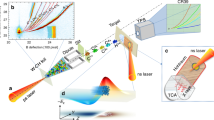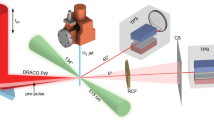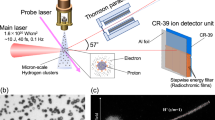Abstract
Particle acceleration based on high intensity laser systems (a process known as laser–plasma acceleration) has achieved high quality particle beams that compare favourably with conventional acceleration techniques in terms of emittance, brightness and pulse duration1,2,3,4. A long-term difficulty associated with laser–plasma acceleration—the very broad, exponential energy spectrum of the emitted particles—has been overcome recently for electron beams5,6,7. Here we report analogous results for ions, specifically the production of quasi-monoenergetic proton beams using laser–plasma accelerators. Reliable and reproducible laser-accelerated ion beams were achieved by intense laser irradiation of solid microstructured targets. This proof-of-principle experiment serves to illuminate the role of laser-generated plasmas as feasible particle sources. Scalability studies show that, owing to their compact size and reasonable cost, such table-top laser systems with high repetition rates could contribute to the development of new generations of particle injectors that may be suitable for medical proton therapy8,9,10.
This is a preview of subscription content, access via your institution
Access options
Subscribe to this journal
Receive 51 print issues and online access
$199.00 per year
only $3.90 per issue
Buy this article
- Purchase on Springer Link
- Instant access to full article PDF
Prices may be subject to local taxes which are calculated during checkout




Similar content being viewed by others
References
Maksimchuk, A., Gu, S., Flippo, K., Umstadter, D. & Bychenkov, V. Forward ion acceleration in thin films driven by a high-intensity laser. Phys. Rev. Lett. 84, 4108–4111 (2000)
Clark, E. et al. Measurement of energetic proton transport through magnetized plasma from intense laser interactions with solids. Phys. Rev. Lett. 85, 1654–1657 (2000)
Snavely, R. A. et al. Intense high-energy proton beams from petawatt-laser irradiation of solids. Phys. Rev. Lett. 85, 2945–2948 (2000)
Cowan, T. E. et al. Ultralow emittance, multi-MeV proton beams from a laser virtual-cathode plasma accelerator. Phys. Rev. Lett. 92, 204801 (2004)
Mangles, S. et al. Monoenergetic beams of relativistic electrons from intense laser-plasma interactions. Nature 431, 535–538 (2004)
Geddes, C. et al. High-quality electron beams from a laser wakefield accelerator using plasma-channel guiding. Nature 431, 538–541 (2004)
Faure, J. et al. A laser-plasma accelerator producing monoenergetic electron beams. Nature 431, 541–544 (2004)
Tajima, T. & Mourou, G. Zetawatt-exawatt lasers and their applications in ultrastrong-field physics. Phys. Rev. Spec. Topics Accelerators Beams 5, 031301 (2002)
Ledingham, K. W. D., McKenna, P. & Singhal, R. P. Applications for nuclear phenomena generated by ultra-intense lasers. Science 300, 1107–1111 (2003)
Bulanov, S. & Khoroshkov, V. Feasibility of using laser ion accelerators in proton therapy. Plasma Phys. Rep. 28, 453–456 (2002)
Modena, A. et al. Electron acceleration from the breaking of relativistic plasma waves. Nature 377, 606–608 (1995)
Malka, V. et al. Electron acceleration by a wake field forced by an intense ultrashort laser pulse. Science 298, 1596–1600 (2002)
Wilks, S. et al. Energetic proton generation in ultra-intense laser-solid interactions. Phys. Plasmas 8, 542–549 (2001)
Gitomer, S. J. et al. Fast ions and hot-electrons in the laser-plasma interaction. Phys. Fluids 29, 2679–2688 (1986)
Hegelich, M. et al. MeV ion jets from short-pulse-laser interaction with thin foils. Phys. Rev. Lett. 89, 085002 (2002)
Schreiber, J. et al. Source-size measurements and charge distributions of ions accelerated from thin foils irradiated by high-intensity laser pulses. Appl. Phys. B 79, 1041–1045 (2004)
Esirkepov, T. et al. Proposed double-layer target for the generation of high quality laser accelerated ion beams. Phys. Rev. Lett. 89, 175003 (2002)
Kaluza, M. et al. Influence of the laser prepulse on proton acceleration in thin-foil experiments. Phys. Rev. Lett. 93, 045003 (2004)
Spencer, I. et al. Experimental study of proton emission from 60-fs, 200-mJ high-repetition-rate tabletop-laser pulses interacting with solid targets. Phys. Rev. E 67, 046402 (2003)
Matsukado, K. et al. Energetic protons from a few-micron metallic foil evaporated by an intense laser pulse. Phys. Rev. Lett. 91, 215001 (2003)
Bulanov, S. V. et al. Feasibility of using laser acceleration in proton therapy. AIP Conf. Proc. 740, 414–429 (2004)
Esirkepov, T. et al. Laser ion acceleration scaling laws seen in multi-parametric PIC simulations. Phys. Rev. Lett. (submitted); preprint at http://arxiv.org/abs/physics/0510189 (2005)
Hein, J. et al. Diode pumped chirped pulse amplification to the joule level. Appl. Phys. B 79, 419–422 (2004)
Damato, B., Kacperek, A., Chopra, M., Campbell, I. R. & Errington, R. D. Proton beam radiotherapy of choroidal melanoma: The Liverpool-Clatterbridge experience. Int. J. Radiat. Oncol. Biol. Phys. 62, 1405–1411 (2005)
Allen, M. et al. Direct experimental evidence of back-surface ion acceleration from laser-irradiated gold foils. Phys. Rev. Lett. 93, 265004 (2004)
Acknowledgements
This work was supported by the Deutsche Forschungsgemeinschaft. T.E. thanks S. V. Bulanov for discussions. K.W.D.L. takes pleasure in the receipt of a Carl-Zeiss visiting professorship. We thank F. Ronneberger and B. Beleites for their technical support. We thank H.-J. Fuchs and W. Gräf for their help in producing the targets.
Author information
Authors and Affiliations
Corresponding author
Ethics declarations
Competing interests
Reprints and permissions information is available at npg.nature.com/reprintsandpermissions. The authors declare no competing financial interests.
Rights and permissions
About this article
Cite this article
Schwoerer, H., Pfotenhauer, S., Jäckel, O. et al. Laser-plasma acceleration of quasi-monoenergetic protons from microstructured targets. Nature 439, 445–448 (2006). https://doi.org/10.1038/nature04492
Received:
Accepted:
Issue Date:
DOI: https://doi.org/10.1038/nature04492
This article is cited by
-
Electron accelerataion by laser driven electron plasma wave in plasma with axial density ramp: Cosh Gaussian laser beam
Journal of Optics (2024)
-
Time-resolved optical shadowgraphy of solid hydrogen jets as a testbed to benchmark particle-in-cell simulations
Communications Physics (2023)
-
The Effect of the Laser Light Polarization on the Generation of Proton Ignitor Beam
Iranian Journal of Science (2023)
-
Enhancement of fusion energy gain due to the injection of solid boron to fuel capsule utilising the deuteron beam radiation
Pramana (2023)
-
Towards bright gamma-ray flash generation from tailored target irradiated by multi-petawatt laser
Scientific Reports (2022)
Comments
By submitting a comment you agree to abide by our Terms and Community Guidelines. If you find something abusive or that does not comply with our terms or guidelines please flag it as inappropriate.



